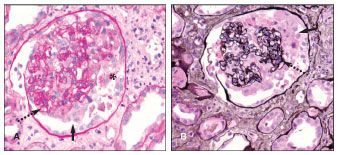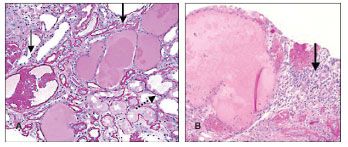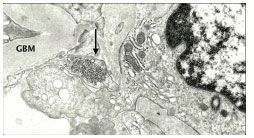- Clinical Technology
- Adult Immunization
- Hepatology
- Pediatric Immunization
- Screening
- Psychiatry
- Allergy
- Women's Health
- Cardiology
- Pediatrics
- Dermatology
- Endocrinology
- Pain Management
- Gastroenterology
- Infectious Disease
- Obesity Medicine
- Rheumatology
- Nephrology
- Neurology
- Pulmonology
Patterns of Renal Injury in HIV-Positive Persons
Since the introduction of highly active retroviral therapy and with the improvement in the survival of persons with HIV/AIDS, the spectrum of renal disease in HIV-infected persons has expanded.
Since the introduction of highly active retroviral therapy and with the improvement in the survival of persons with HIV/AIDS, the spectrum of renal disease in HIV-infected persons has expanded.1 The clinical presentation of renal injury in the HIV-infected population is diverse and reflective of the underlying renal pathological process. HIV-related renal diseases show demographic characteristics, with ethnic and geographic predilections. There is an established racial predilection for HIV-associated nephropa-thy (HIVAN) in African American adults, for whom there is also a higher incidence of severe renal disease. HIV-related immune complex diseases are more frequently seen in white adults, who tend to have milder clinical presentations. While ethnic differences have also been suggested in the pediatric HIV-positive population, this has not been fully demonstrated.
The diverse morphological presentations seen in the kidney are secondary to multifactorial insults, including local HIV infection, other viral and opportunistic infections, and multidrug-induced toxicity.2 Furthermore, the prolonged survival of HIV-positive persons adds an increased risk of chronic renal disease related to the development of hypertension and diabetes. The causes of renal failure in HIV-positive persons is broad and includes HIVAN, thrombotic microangiopathy, immune complex–mediated glomerulonephritis, and drug-induced nephropathy.3-5 Renal biopsies have become increasingly useful as a diagnostic tool and in guiding clinical management of renal disease in the HIV-positive person.
The most common HIV-related renal disease is HIVAN, with both clinically and pathologically distinct characteristics.3,4 In the pre-HAART era, HIVAN was a manifestation of advanced HIV disease; however, with the introduction of effective antiretroviral therapy, HIV-positive patients may present at any stage of their HIV infection with acute onset of heavy, nonselective proteinuria, often with negligible peripheral edema, normal blood pressure, and progressive renal insufficiency. In this setting, the renal biopsy typically shows glomerular, tubular, and interstitial changes. The glomeruli most commonly show collapsing variant of focal segmental glomerulosclerosis, with capillary collapse and obliteration and visceral epithelial cell hypertrophy and hyperplasia (Figure 1).

Figure 1.Collapsing glomerulopathy. A: Glomerulus with segmental capillary collapse (dotted arrow) and visceral epithelial cell hyperplasia and hypertrophy (solid arrow). Protein resorption granules (*) are present within epithelial cells (periodic acid-Schiff stain, original magnification ×400). B: Glomerular capillary collapse (dotted arrow) with extensive visceral epithelial cell hyperplasia (solid arrow) (Jones methenamine silver stain, original magnification ×400).
Alterations of the visceral epithelial cell, or podocyte, are implicated in the pathogenesis of HIVAN.6 Tubulointerstitial damage in HIVAN is typically severe, with extensive tubular injury, varying degrees of tubular atrophy, interstitial fibrosis, inflammation, and edema, depending on the phase of the disease (ie, acute or chronic). Characteristic pathology is the formation of tubular microcysts, filled with proteinaceous casts (Figure 2). Ultrastructural analysis shows tubuloreticular structures within glomerular and interstitial capillary endothelial cells (Figure 3). Although less frequently observed with the wide use of effective antiretroviral therapy, the presence of tubuloreticular structures may raise the possibility of HIV infection in a person not yet known to be infected. Other patterns of glomerular injury seen in HIVAN include mesangial hypercellularity and minimal change disease, similarly showing prominent tubulointerstitial damage when compared with the non–HIV-related forms of glomerular injury.3 When all these features are recognized, in conjunction with a thorough clinical history, the renal biopsy can lead to a diagnosis of HIV infection.7

Figure 2. Tubular injury. A: Dilatation of tubules with luminal proteinaceous precipitate (solid arrow). Several proximal tubules with epithelial simplification and lack of brush border (dotted arrow). Sclerosed glomeruli (open arrow) (periodic acid-Schiff stain, original magnification ×200). B: Tubular microcyst formation and interstitial inflammation (arrow) (periodic acid-Schiff stain, original magnification ×200).

Figure 3. Tubuloreticular inclusion within cytoplasm of glomerular capillary endothelial cell (arrow) (transmission electron microscopy, uranyl acetate–lead citrate stain, original magnification ×10,000). (GBM, glomerular basement membrane.)
Additional glomerular lesions reported in HIV-positive persons are immune complex–mediated glomerulonephritides. The most common is membranoproliferative glomerulonephritis, frequently seen in persons coinfected with hepatitis C virus. Membranous glomerulopathy, IgA nephropathy, and lupus-like nephritis with or without positive results on serological tests for lupus are also documented. Hemolytic uremic syndrome/thrombotic thrombocytopenic purpura can be a cause of acute renal failure in HIV-infected persons. The pathogenesis of this unique relationship is unclear.
Tubulointerstitial diseases include interstitial nephritis and acute tubular necrosis (Figure 4) secondary to drug toxicity. Among the insulting agents are antiretrovirals when given in multidrug regimens, medications for comorbid diseases, and NSAIDs. Clinically acute interstitial nephritis should always be considered when creatinine levels increase after introduction or reintroduction of any drug treatment in the absence of any other explanation for renal dysfunction.

Figure 4. Interstitial inflammation. Dense lymphoplasmacytic infiltrate within interstitium with tubular damage (arrow) (periodic acid-Schiff stain, original magnification ×200).
Considering the varied forms of renal compromise seen in the HIV-infected population, it is essential that clinicians treating HIV-positive patients are aware of and understand the different clinical and pathological presentations of HIV-related renal disease.
References:
References1. Fine DM, Perazella MA, Lucas GM, Atta MG. Kidney biopsy in HIV: beyond HIV-associated nephropathy. Am J Kidney Dis. 2008;51:504-514.
2. Roling J, Schmid H, Fischereder M, et al. HIV-associated renal diseases and highly active antiretroviral therapy-induced nephropathy. Clin Infect Dis. 2006;42:1488-1495.
3. D’Agati V, Appel GB. Renal pathology of human immunodeficiency virus infection. Semin Nephrol. 1998;18:406-421.
4. Wyatt CM, Winston J. Renal disease in patients with HIV. Curr Infect Dis Rep. 2006;8:76-81.
5. Cohen AH, Nast CC. Renal injury associated with human immunodeficiency virus infection. In: Jennette JC, Olson JL, Schwartz MM, Silva FG, eds. Heptinstall’s Pathology of the Kidney. 6th ed. Philadelphia: Lippincott Williams and Wilkins; 2007:chap 9.
6. Lu TC, He JC, Klotman PE. Podocytes in HIV-associated nephropathy. Nephron Clin Pract. 2007;106:c67-c71.
7. Fine DM, Atta MG. Kidney disease in the HIV-infected patient. AIDS Patient Care STDS. 2007;21:813-824.
Â
